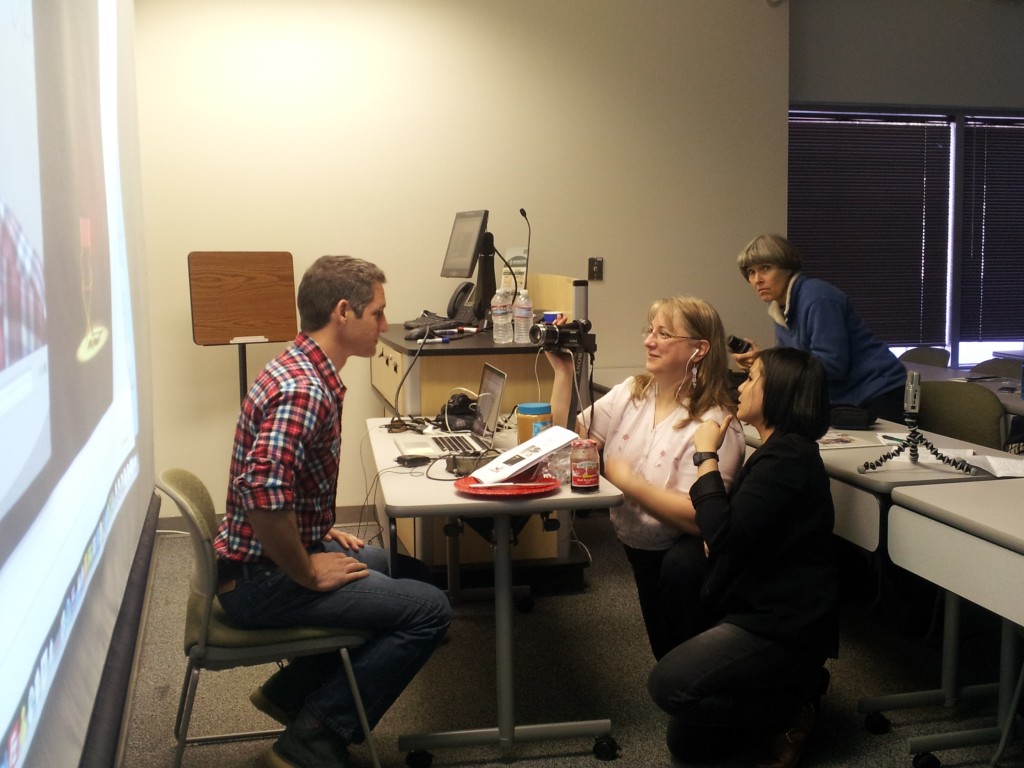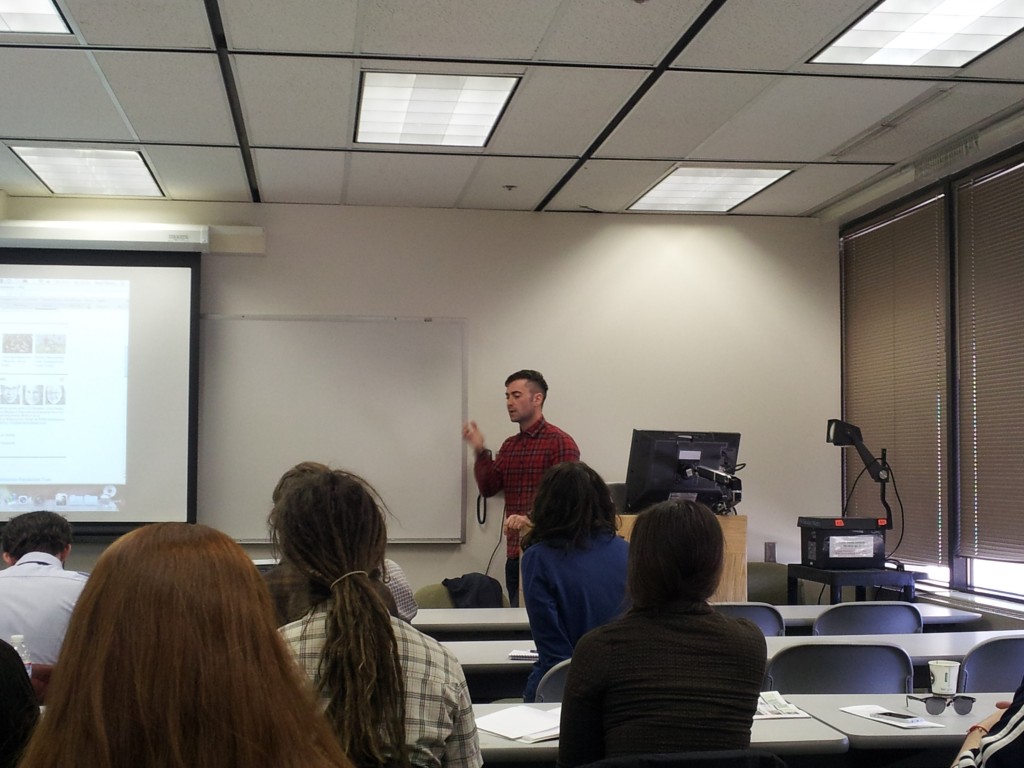
By Day 3 of the Alaska Press Conference, we’re all pretty inspired. Now we’ve got so many great ideas to take back our newsrooms.
Fast Track Video – Lam Thuy Vo | Multimedia reporter, data journalist and coder for NPR’s Planet Money | @lamthuyvo
“Think of video as the anecdotal lead.”
Video examples
NYTimes – Physics Teacher, Mr. Wright “Wright’s Law”
>
Planet Money – Potato Chip factory – “Secrets of the Potato Chip Factory
Finding a really good character takes a long time. If you find someone who is special, invest the time and then you can really show through that character what it means to be that person.
Video makes you care from a bigger emotional, ‘I want to jump up and do something’ level.
Video give you the ability to explain something complex very quickly.Video also equals money. The ads you can sell for video are much higher than anything else. Video has figured out the sponsorship method on mobile.
Before you decide what kind of videos you want to do you need to know what you’re going for and come up with a strategy.
- First person narrative – find a character and tell a story
- Produced news package – news voice overs with footage
- Raw footage – has become a big deal, you are the eyes of your audience on the ground
Video in breaking news scenarios doesn’t have to be beautiful. People understand. People don’t understand when you produce crap and you had a lot of time.
What does that mean for your stories?
Before you go out, ask yourself
- Do you have a character? (Not everyone is worthy of being on camera)
- Do you have access? (People are afraid of recording devices)
- Do you have time? (It takes a lot of time to produce good video)
If you want to do great documentary type video, pick your battles. Life doesn’t move at the pace of your deadline.
Anatomy of a video – Things you need to record:
- Interviews and narration, radio track – ways of delivering facts, summaries and emotions
- Natural sound – enrich the piece, by introducing the feeling of a place
- Music – help propel the story with tone
- Visuals – think of the interview as a way of introducing the character, B-roll for context
Components
The Interview
- Who are you, what do you do
- Tell me, describe
- How do you feel about
- How do you picture the next TK years/what do you to do in the coming years
Don’t settle for one word answers, ask people to explain.
Once you have all these things, use your notes in a scavenger hunt for B roll
Everything that has been said needs to be shown in video later.
Framing
- Use an grid (rule of thirds)
- Whenever you can monitor sound, make sure you do. People underestimate the importance of sound. (Use a quality microphone, tripod, camera)
How not to shoot
How to shoot
- 10 second clips
- Don’t Move
- Zoom with your feet, not the camera
- List to the sound
What to shoot – The 5 shot method
- Close up of person doing something with their hands
- Closer to the face (show both eyes)
- Go to medium shot, give details on the environment, context
- Over the shoulder, puts you in the person’s perspective
- A fun shot at an unusual angle
Having a shot list can give you a way to mentally order what you’re shooting.
Doing a documentary well is 80% B-roll. What the interviewee says has to be shown in video. An average shoot is about an hour interviewing and about 3-4 hours shooting B-Roll.
Voice over on many levels is a crutch for people who couldn’t/didn’t spend enough time with interviews.
Organizing your reporting
3 stages of a video shoot – before, during and after
Before the interview go for the obvious stuff.
- Establishing shot (building exterior, signs–anything that helps establish a scene)
- During the interview – take notes. Use those notes like a scavenger hunt list for b roll shots. After the interview get the video of whatever the person talked about in the interview.
- After the interview – ask them to give you access to what they talked about. Show what they talked about. If you don’t have it, you won’t be able to get the video later. Make sure you have your notes and use it like a checklist. Don’t leave before you get those shots.
Organization is what makes you faster and keeps you from forgetting shots.
Mobile Reporting Field Guide from Berkley
Freelancing Panel – With David Holthouse, Wesley Loy, Sarah Gonzales, Carol Simons and Lew Simons. Moderated by Lynne Lott.
Have a story idea, don’t go looking for people to assign you stories.
Lott: If I had a great idea, I’d be writing it, or one of the staff would.
Holthouse: Best way to break into freelancing is if you got a story that’s not right for where you are and you know you can knock it out of the park. Go ahead and do the story even if you got to pay out of pocket and then sell the story.
C. Simons: Even if you have 5 ideas on a subject, send me 5 short pitches and I would pick one of the 5. If you’re really new I might only pick one, but pitch and pitch. Know your subject and remember that you have to earn money. And earning money means sometimes writing something you don’t like. (corporate magazines, business copy, etc.)
L. Simons: He got into freelancing late in career. After being abroad on his own, realized he couldn’t fit into a newsroom setting anymore and moved into freelancing. Had a lot of clips and contacts to he was able to get hired quickly.
“Every freelancer dreams of getting assignments.”
Loy: When you have a beat you can parlay that into a freelance story. If you’re going to freelance, you can’t be lazy.
Gonzales: Freelancing is really hard to do full time. You have to put in a lot of hustle to get a story done. Instead of doing small one of freelance gig, I do more long term contract type jobs. You need a network of people to work with. As an independent, it’s pretty lonely. You need contacts to work with.
How do you get the attention of an editor?
Loy: Making pitches is hard, you need to know your story and have contacts.
C. Simons: Never let a business card go unclaimed. Ask people if you can pitch them. They’re not going to say no. It doesn’t matter if you get rejected, it only takes one acceptance.
L. Simons: Cast that net wide. You’ve got to have people you can reel in from everywhere. If #1 doesn’t buy then try #2 #3. Nothing says that if you sell to #1 doesn’t mean you can’t repackage and sell to #2. The best people in freelance do that again and again.
Making a Living
Loy: Think about whether you’re freelancing to make a living or to follow stories you’re passionate about.
L. Simons: The way I look at freelancing, is that the answer lies between paying the bills and doing what your passion dictates. I think you can do both. For daily papers, pitch their weekend pages or op-ed (if you have expertise) The longer your resume gets and the more bylines you have, the better the chances you have for the next assignment.
O’Malley: A good way to find where the money is to watch the bylines for “special to” or something different than the standard staff byline, that’s where there is a budget for freelancers. Make a contact with the editor for that section.
Holthouse: Unless I have a relationship with the editor I don’t pitch them. I send them an entire story. If I have a relationship, then I pitch. If you have a great idea for a story, tailor it for the voice of where you want to pitch it.
Townsend: If you’re going to make pitches to orgs you don’t have a relationship with, research them, know their deadlines, know who to talk to. Be clear about what your pitch is. Call in the morning, not late in the day when people are busy on deadline. If multiple outlets want your pitch and it’s already been bought, tell the second outlet the pitch from that angle was sold but offer them a new angle.
L. Simons: If you are happy doing what you’re doing, writing what you want, going where you want, and the pay isn’t that good, it won’t matter. Nobody goes into journalism to get rich.
Gonzales: The people who take the assignment, do it, take feedback are the ones that keep getting work. The ones who get possessive don’t get a second job.
Social media news gathering – Neal Mann | Social Media editor at the The Wall Street Journal | @fieldproducer
Got into social media because as an industry we need to change. We always broadcast to people, but there are whole worlds of conversation happening on social media and we need to engage with them.
When people consume any news story, they do it on multiple platforms now. People are consuming it in real time as it happens.
The second screen experience is becoming more common. Using social while using TV.
Traditionally stories that have video on web story sit above the copy and the video would be the same information as the copy. There is no point in that.
Example of journalist actually pulling out phone and grabbing some video while other journos stood around just taking notes.
The traditional tv news package is not designed for the internet. So how do we use video content?
This CNN story buries their video under the print.
Wired: Up: the story behind Richard Branson’s goal to make Virgin a galactic success example of engaging design. (It’s so gorgeous, this is what news was meant to look like)
About 20% of the audience get to the bottom of the page in most news stories.
There is a moment in time when news starts and most of the time now, that moment happens on social media.
Lots of news orgs are finding that they’re in the world of very fast mistakes. Anyone in news online is now a 24 hour news organization. The how-to and the why often get lost in rush for the next update.
When working on projects, think about how can you create something that lasts, that people can engage with?
View the full day’s notes here.
Want to check out Bernardo Ruiz’s keynote speech? Alaska Commons has video here.


